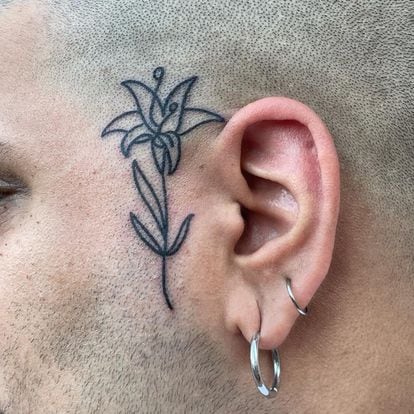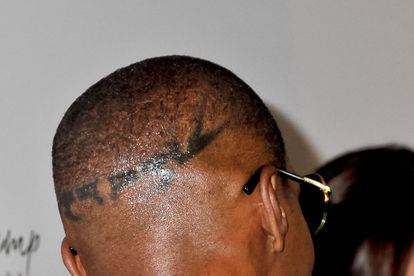“The tattoo on the face is not like before,” said singer Pimp Flaco during an interview in the program Grimey a week ago. “It’s not like five years ago. Now it’s almost normal. Before, when only four or five of us in Spain had our faces tattooed, it was something crazy, it was like saying I hate everything. But now I’m even too lazy to do more because it seems like you want to look cool.”
The statement is bold. In fact, some comment ironically pointed out the supposed exaggeration of the Barcelona artist who has, for years, had a rose tattooed on his right temple: “Yes, yes, super normal, my grandmother has a couple of friends with their faces tattooed.” It’s true, it’s still weird to have a tattoo on her face. But it is also undeniable that in recent years this practice has ceased to be the exclusive property of the world of trap and urban music. To begin with, before them was the boxer Mike Tyson, a pioneer in facial tattoos, who in 2003 planted a tribal tattoo in the middle of his face that, he said, “highlighted his warrior spirit.” Another precursor of this daring gesture was the television collaborator Coto Matamoros. In Jordi Wild’s podcast he recounted how he decided to get his skull tattooed after smoking two opium pipes with his tattoo artist.
After them came the generation that invented trap, which elevated facial tattoos to the category of aesthetic movement. Kinder Malo, singer and brother of Pimp Flaco, became a living manifesto by tattooing the phrase “animals are not food” on his forehead. Cecilio G, known both for his music and for his controversies, sports an unfinished Gyarados, (a water-type dragon Pokémon) on his abdomen and the hammer and sickle on one of his biceps. However, his most distinctive feature is the cross that adorns his forehead, for which he has never provided an explanation. Yung Beef has his children’s names written on his face, and Kaydy Cain, her bandmate in the group Pvvr Gvng, sports a kiss on one side of his face and an ice cream cone on the other. During his appearance on the show The resistance He explained that by getting these tattoos an irrevocable commitment to music was imposed, aware that with them the doors to conventional jobs would be closed.
In the post-trap era, different pop culture icons have immersed themselves in the world of facial tattoos, with varying degrees of daring. Justin Bieber inscribed the word ‘grace’ above his eyebrow, as a subtle declaration of faith. Actress Cara Delevingne got a tattoo of a diamond inside her right ear and, on the outside of the same ear, she engraved four stars in the shape of the Southern Cross constellation, a symbol of Brazil that was drawn during a trip to Rio de Janeiro. Actor Jamie Foxx has a large tribal tattoo on the back of his head that, according to what he said in an interview, was done for his 40th birthday.
The next, somewhat inevitable step is that the face tattoo has hit the streets. “Unquestionably, these types of tattoos have become a trend in recent years,” says literary critic and literature professor Nadal Suau, who has just won the Anagrama Essay Prize with his book, in conversation with ICON. Heal skin, in which he reflects on this art. He classifies facial tattoos under the category of “unruly tattoos.” This group also includes ironic tattoos, magnificently represented by the face of Arturo Valls that the singer Samantha Hudson engraved on her buttock in 2019. She also adds what she calls “ugly, dirty or violent” tattoos, such as painting on the skin the anus of a cow, and which he considers “a bad taste that disobeys the imperative of homogeneous beauty.”
“I will probably never get a tattoo on my face, although obviously you never know,” the author admits. “It can be considered the last frontier, the type of tattoo that has not yet been normalized, that still maintains the ability to cause concern, to generate questions, to capture the gaze of the passerby. Although fashion has attempted to capitalize on this trend, a strong element of taboo persists.” He claims that a facial tattoo can radically change others’ perception of the person wearing it. “And beyond the gaze of others, a change as extreme and beastly as a tattoo on the face can profoundly influence how a person sees themselves,” he reflects.

Nadal Suau directly links the fashion of face tattoos with the emergence of the trap movement a few years ago. “In fact, in the recent history of tattooing, it has often been music stars, especially rock figures, much more than athletes, who have driven the development of this art form. It is the ragpickers who have placed the facial tattoo in the spotlight, assigning it a dimension of aesthetic trend,” he defends. He highlights the influence of youth countercultural movements on the decision of people like him to get tattoos. “The most recent change, the one that has led someone like me to get tattoos, is rooted in these countercultures. Among them, music has always played a prominent role due to its character as the most universally accessible art and its ability to unite groups, from the times of Janis Joplin to the present day.”
Last February, Julia Bermejo, who has worked as a bookseller for fifteen years, decided to get a sun with boots tattooed on one of her cheeks, designed by JLR, a Sevillian tattoo artist who reinterprets the Andalusian imagery with a personal approach. At that time, she already had several tattoos on her body. “My mother would say many, I would say few,” she jokes. She became the first when she was seventeen or eighteen years old. “It was a time when there weren’t so many tattooed people, but I had that obsession in mind.” She did not mark her body again until she was 30 years old. “I had a shitty breakup and I thought the best thing was to stop by and leave a record of transit, sometimes we give tattoos the same meaning as the entry in the diary but on our own skin.”
After that tattoo, others followed, forming a collection mostly adhered to the style called black work, with certain touches of traditional tattoo. The decision to get a face tattoo arose more from a spontaneous impulse than from detailed planning. “I saw designs and people with tattoos on their faces, until, suddenly, I decided to do it. It’s similar to having a book on your bedside table for seven weeks and, one day, just like that, you start reading it in one sitting.” Regarding working in front of the public, she points out that, as a woman, there will always be criticism and prejudices to face, regardless of how she presents herself or acts. “What do you want me to say? You are always going to be too childish or banal for some people. And it doesn’t matter, even if I was dressed perfectly, someone would always come in who wasn’t going to take me seriously.”

Bermejo has learned to tattoo himself respecting an ethical fate that orders prioritizing the body areas to be tattooed based on their sensitivity and visibility. “It is advised that beginners initially avoid highly sensitive areas, such as the stomach, so that they can first get used to the process in less painful and more discreet areas,” she explains. This makes it easier for the person to discover their pain tolerance and reaction to the tattoo. Bermejo has come to the conclusion that, even if one wants to, “there are social codes that are difficult to transcend.” That is why she has chosen to respect these unofficial rules. “For me, doing it this way is the healthiest thing. Although of course, if someone wants to violate these codes, that’s great for me.”
Álvaro Costa, better known as Cos.915 In the tattoo scene, he identifies with a new trend of artists who do not follow certain traditional rules or established ethics that dictate a specific order for tattooing. “No offense intended, I think that perspective is a bit oldcock”, he comments. He started in the tattoo world at the age of 16 as a Hobbie and, after three or four years, he decided to become a professional in this artistic discipline. Like other members of the new generation of tattoo artists, he makes it a rule to exclusively engrave his own designs. “For me there are two big worlds within tattooing. One is the traditional studios, like the ones you can find on Montera Street. There, the client can have the design they want, and the tattoo artist is limited to doing it for them. Let’s say that it is an eminently artisanal method. On the other hand, I only tattoo my own designs. Sometimes I can adjust it to an idea that the client has, but I only work from my own ideas.”
He has done several tattoos on his face, a practice that he considers increasingly common. “I have tattooed very cute, like butterflies and, above all, flowers, generally in the sideburn area, next to the ear. At the moment only boys,” he says. From his perspective, any stigma attached to facial tattoos is an outdated concept, and the real commitment lies in what the tattoo itself symbolizes. “A swastika tattoo would undoubtedly have consequences no matter where you get it. But a flower, for example, even denotes sensitivity. It also depends on how you approach your life or in what circles you move. I have seen people in Europe working with tattoos in the face in any job.”

After the victory of the Argentine team in the World Cup in Qatar, a soccer fan went viral after tattooing Messi D10S on his forehead. At first he seemed proud, probably absorbed by the atmosphere of collective euphoria. But just a couple of weeks later he posted a video on social media in which he regretted the decision. “I felt very proud the first few days, but I must confess that I regret having gotten the tattoo,” he said. “Instead of bringing me positive things, I am experiencing thousands of negative things personally and as a family.” And he added that his closest relatives had criticized him for “not being a positive example for society.” Luckily for this young man, as quickly as the fashion of tattooing on the face advances, treatments to erase them are improving.
You can follow ICON on Facebook, x, instagram,or subscribe here to the Newsletter.
#considered #frontier #live #tattoo #face #fashion #jumps #trap #streets
